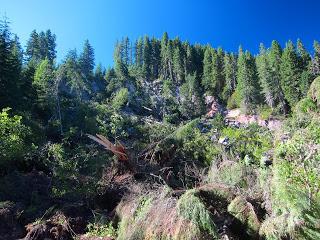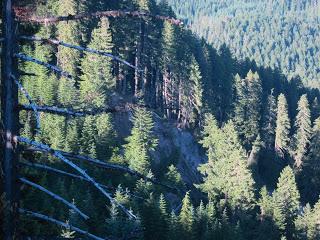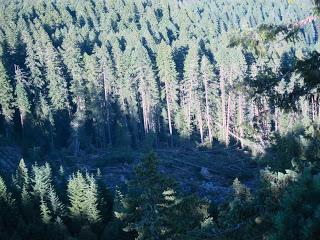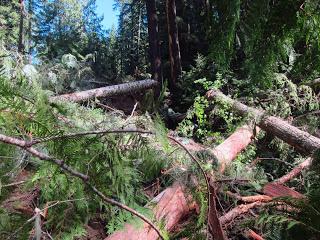Author’s note: This is a factual account of recent events in the Willamette National Forest. The events are true, but names have been changed on behalf of folks involved. For more information email [email protected]
By Darlingtonia Cascadia and fellow surveyors / Forest Defense Now

It was the first night of the survey season, and we were busy setting up camp on a spur road deep in the Willamette National Forest. The Northwest Ecosystem Survey Team (N.E.S.T.) is here to survey the remaining 44 acres of a
zombie timber sale known as Trapper. Over ten years in process, the sale has been whittled down to it current size through a series of lawsuits as well as being buffered out for red tree voles. N.E.S.T. sends out teams of volunteer surveyors every year in search of red tree vole nests, which are an indicator species for the spotted owl. We do this in the hopes of buffering 10 acres of old growth forest into protected status. And so far N.E.S.T. has been successful.
On this Wednesday night, camp has been set up and folks are taking in the sounds of this Oregon old growth forest: the creek down below, the wind in the upper canopy, and the occasional mosquito looking for it’s nightly meal. Interrupting the peaceful sounds of the night is the crack of a trunk, the snapping of limps, and a thunderous landing of a 175+ foot tree deep in the forest.
Brook shoots up with a startle. With all her experience defending the forest, she’s had her fair share of close calls with falling trees. “That was a tree. A real big one”.
Everyone looks at each other as if they’ve finally heard the answer to the perpetual question “If a tree falls in the woods and no one is around, would it make a sound.” This time, someone was around. Everyone takes in the moment and heads to their respective tents. Brook, probably flashing back to a really close call, crawls into her truck which is protected by a lumber rack. It’ll take her awhile, but she’ll eventually fall asleep.
The next morning everyone does their morning ritual of coffee, oatmeal, and a trip to the trench latrine. Not everyone goes in the same order. The song birds have come out only to be punctuated by another tree falls. Brook doesn’t believe it, two trees in less than twelve hours. This is unheard of in his experience, especially his years with N.E.S.T. He eyes the trees across the road in Unit 22, and reminds folks to be careful about snags and hangers. Everyone takes the advice in stride, and heads into the unit for a day of shooting a line into a old growth Douglas Fir.
The day brings frustration and disappointment with mechanical failures with the cross bow. The fishing line snaps, arrows airmail into oblivion, or the crossbow string is on the brink of breaking. But it’s also interrupted by yet another tree falling. And another. And even yet another. We start counting them as they happen, steadily getting even more surprised as the number creeps up to 10. Ten trees in less than 18 hours.
As I’m coming down from the Douglas fir, the percussive rhythm of the trees has picked up. As I’m giving an impromptu climbing lesson to two new volunteers, Bill and Daryl, the trees are coming down so swiftly that it’s difficult to keep count. When the next falls, I say 23. Brook hollers from back from base camp, 25. We must’ve missed a few. This time he was able to see the top of the last tree falling, and calls us to get out of the unit. Fearing the trees are falling in our direction, we grab our gear and run to the safety of camp. The cadence of trees becomes even more frenetic, and appears to be picking up steam. The sounds are accentuated by the smashing of boulders into the trees, splintering them upon impact. The sound of explosive trees isn’t lost on us. It’s the fourth of July and nature is giving us the explosive sounds of a firework display. This is unheard of in Brook’s experience, and the concern is slowly creeping in the collective consciousness of the group. Bill, Daryl, and I are overcome with curiosity. We grab a unit map showing the local terrain, a compass, and a camera to document to carnage. Bill is kicking into his natural role of a front line activist, his concern that this might be logged illegally. “If they’re logging this, we’ve got to stop it”, he quips as he dashes down the road.
We first head east along forest road 1517 in the direction of most of the activity. We find a crook in the road cup of our ears attempting to echo locate the source of the destruction. The forest is so thick, we can’t see a tree move but the sounds are definitely coming in that direction. Looking over the map, we decide a route from what will be the upper left hand side of the source. We have to run back along the road, and around Unit 22. There’s a bend in the road and we decide this is a safe distance away from the sounds, and start cutting through the woods. We cut up the ravine and push through some of the rhododendron understory. There are large majestic old growth trees all around us, as this is part of the unit that was previously saved via found red tree vole nests. There’s a ridge heading west, and we follow it up until we think we’re above the falling trees. According the map, and from reviewing some of the timber sale documents, there’s an old clear cut right where the sounds might be coming from. Sadly, that area wasn’t saved.
After crossing a few washes, ridges, and finally appearing on a rock outcropping, we finally see what we’re looking for. We weren’t prepared for what we saw. It looked as if the earth had opened up and started taking in anything that it could reach. Trees were hanging in all unnatural angles, some perilously sitting on the sheer edges of freshly cut cliffs. Below was a pile of trees, each over a hundred fifty feet tall, as if the goddesses had decided to play a casual game of pick up sticks. Unfortunately, these sticks could and would not be picked up. Only seeing a portion of the apparent landslide, I free climb the closest tree to get a better view. Overcome with the desire to take it all in, I disregard having gear and head up the the thumb sized branches.
Once at the top, it’s very obvious what we were looking at. The location of the clear cut was true, and the ground had loss it’s cohesive layer that saves it from destruction of this sort. It’s part of most logging operations to incorporate a reclamation plan to protect the land and streams from surface soil run off. And when they attempt to reforest what can only be done naturally, they do a shitty job. And this is what happens. The head wall of the slide is about 20 feet tall and runs steeply downhill for 500 feet, which is most of the way down the mountain. Clear cuts in themselves are a completely destructive operation. But do it on a steep hill side, a ravine at that, and you have catastrophe a Cascadian thunderstorm away.
After snapping a few shots that can’t take in the grandeur of what was before us, we head back towards base camp. We still can’t believe what has happened, but we can’t wait to share the news with our comrades. Hopefully this can put some of the concerns to rest that the area is being logged. As we approach camp, we’re greeted with Rocks and Neil loading up camp. It seems as if Pete, our weathered survey veteran, has concluded by the immensity of the sounds that it had to be a surprise logging operation. Brook and Pete debate how loggers managed to punch through a logging road without the typical army of equipment. For a lack of information, the reasons begin to embellish, maybe the possibility of a new no chainsaw technique involving wedges. Pete swears he heard the ratcheting of equipment, or thought he heard the rumor of another forest road coming from the north. With all these possibilities adding up, the decision to bug out becomes even more necessary. With the growing fear that this might be an illegal logging operation, the volunteers think this is no long the time for surveying. It might be time for direct action. The group welcomes our return, but blown away by the report that the destruction is an actual landslide.
The next morning the whole group will visit the same road we were standing at the bottom of, only to be met with a fallen Western cedar across the road, two feet across at it’s midway height. These aren’t young trees falling into earth being pummeled by soil and boulders. These are old growth beauties are getting hard to find here in Oregon after years of pillaging by the timber industry. We take a hike through the pile of the flotsam of trees, and we take the view in. The landslide has made it’s way all the way down to the road. The destruction is complete, every tree in it’s path has been tossed, splintered, and destroyed.
We all look at each other taken aback by this apparent ecocide that is allowed by the forest service and perpetuated by the timber industry in the name of jobs. It’s disheartening to see total destruction of such a beautiful place, but we don’t let it stop us. We gather up our gear, and head into the upper part of the unit. The rhythm of the falling trees has slowed down, but our pace to look for red tree voles picks up. The sooner we find these nests, the sooner we can stop Seneca Jones from logging the last 44 acres. Brook grabs the cross bow, and shoots a line. “Looks good. Put a rope in it and let’s climb.” And off goes Jennifer in search of the elusive red tree vole.




